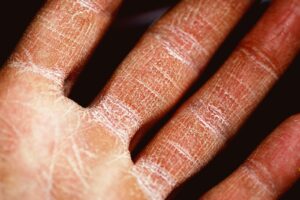Air Quality News reporter Chloe Coules investigates the growing problem of damp and mould in social housing and the impact it has on the most vulnerable tenants.
‘I have been crying non-stop every day, crying like a helpless child. I have been screaming and shouting in my flat, and normally I am a very quiet person. I am boiling over with anger, I’m absolutely furious and filled with rage.’
Afia moved into her social rent flat in 1991, when she was just 23. In December 2021, her housing provider One Housing Group sent contractors to measure for new lino in her bathroom, following flooding from under her bath, and discovered black mould on the floorboards.
Afia commissioned an independent inspection, which found that the mould was most likely Stachybotrys Chartarum, known as toxic black mould.
‘I was trapped in my flat with dangerous black mould. No one could visit me because of the stench: I stank, my clothes stank. I took time off work because I was so sick,’ she says.
For some time, Afia has been experiencing a range of unexplained health issues, including breathing problems, itchy skin and allergic reactions, severe headaches, nausea, fatigue, upset stomach, brain fog and light headedness. The combination of discovering the toxic mould in her flat and contracting Covid-19 has also had a severe impact on her wellbeing.
After over 30 years in her home, Afia packed an emergency suitcase and left her flat on 29 January, and she has not been back since.
‘I had to pay for my own hotel, and I am using up my savings, while also paying rent on my flat,’ she told Air Quality News.
‘Social housing is for tenants; tenants are supposed to come first, not last. Officers are supposed to serve tenants, not treat them like a nuisance.’
In response to her story, the Chief Operating Officer of One Housing, Chyrel Brown, told Air Quality News that they ‘strive to provide the highest standards of service and understand how important a well-maintained home is for [their] customers’. She added that they thoroughly investigate when they receive a complaint, and in this case following initial repair work they offered the tenant a dehumidifier and cleaners attended to remove patches of mould, and are keen to return to the property to ensure any issues are fully resolved.
However, Afia is just one of many social housing tenants whose lives have been turned upside down by persistent damp and mould problems.
Mould and damp are one of the main causes of respiratory illnesses, with reports that over 10 million families are living in damp houses in the UK.
A campaign group supporting social housing tenants, Social Housing Action Campaign (SHAC), told Air Quality News: ‘Damp and mould are the single biggest disrepair problems that our members complain of. Almost every day, tenants and residents of social housing landlords contact us about the squalid conditions they are having to live in. Thousands of people struggle in unfit homes.
‘There is no economic excuse for these conditions. Housing association L&Q in particular seems to have difficulty in providing decent, habitable homes even though they made an operating surplus of £279m in 2020. One Housing Group features regularly despite an operating surplus of £6m. Clarion has an appalling record on addressing disrepairs but boasted to investors last year of a £258m operating surplus. It is not just the large associations with sprawling estates though. Housing for Women, a smaller association housing vulnerable women, seems equally unwilling to make sure that their homes are fit for habitation.
‘Tenants and residents contact SHAC because the initial problems are compounded by completely ineffective systems for alerting the landlord and getting something done. Neighbourhood managers have largely been abandoned. Tenants are now directed to telephone or online helpline systems, just to get stuck in an endless loop of reporting their problem but nothing happening, no matter how many times they chase it up.
‘The disgraceful reality is that the RSPCA would act immediately if we reported such conditions for an animal, but neither landlords nor government provide an equivalent, immediate system of redress when people are living with these terrible hazards. The social housing model is an entirely broken system that needs radical reform, considerably strengthened by tough regulation, and most of all, meaningful power for tenants and residents.’
All of the housing providers mentioned by SHAC told Air Quality News that the safety and wellbeing of their tenants is their priority. L&Q said that their seven-year major works investment programme will target homes that have historically suffered from mould and damp, while One Housing stated that they intend to invest nearly £1bn in improving and repairing homes over the next five years.
Housing for Women have invested over £3m across their stock in the last year and have developed a mould and damp register based on customer feedback and have commissioned a full stock condition survey to inform future investment.
Lifestyle versus maintenance
Architect and author Tom Wooley explains that there is a long history of the responsibility for damp and mould problems being thrust onto tenants in his book Building Materials, Health and Indoor Air Quality.
‘For many years, condensation problems were blamed on the lifestyles of occupants, particularly in social housing, where excessive moisture came from such “anti-social” activities as washing and drying clothes, bathing, boiling kettles and using the wrong kind of heaters!’
However, research has since verified that construction and external factors play more of a role in the development of these issues than tenants’ behaviour.
Marion Lloyd-Jones, Service Design Lead at People Powered Retrofit, explains: ‘You create condensation in the house just by living in it – by breathing, cooking or washing – people make moisture. Our housing stock is 100 years old, and we do not live in these houses the same way that we used to live in them 100 years ago. So, if nothing has been done to the house to change this then of course we are going to get damp issues. These houses were designed to have a fire burning in every room, and now we have central heating, so our expectations of our homes are different now to when they were built.’
Marion says there are several lifestyle changes that people can make to reduce the amount of moisture they produce, such as using a tumble dryer instead of hanging clothes up to dry or investing in a dehumidifier, but for many low-income households these measures are not always economically viable.
People in fuel poverty are also often more susceptible to damp and mould because colder air cannot hold as much moisture, so if a home is underheated, moisture condenses onto walls and windows, creating the perfect conditions for mould to reproduce.
‘Damp and mould are inextricably linked with badly insulated and ventilated houses, so fuel poverty is an indoor air quality issue,’ explains Tom Wooley in his book.
With energy bills set to rise by over 50% in April, The Resolution Foundation estimates that the number of families living in fuel poverty in England will treble.
This raises questions about the long-term impact of the worsening cost-of-living crisis on the prevalence of damp and mould issues among the most vulnerable households in the UK.
The impact on tenants
Mould and damp can lead to a range of health issues, including asthma, eye irritation, respiratory problems like wheezing and difficulty breathing, chest tightness, cough, throat irritation, skin reactions and rashes, headaches and persistent sneezing.
Even more serious problems can result from exposure to toxic mould, which is produced from mycotoxins.
This can especially affect social housing tenants, with over half of households in the social rented sector having a member with a disability or long-term health condition according to the English Housing Survey, making them more vulnerable to the health risks presented by mould.
Kim, another social housing tenant, has lived in her property in London for nearly 25 years. She tells Air Quality News that there is black mould on the windows in her living room and on her bedroom walls, as well as green mould on her belongings and her wooden bed frame.
‘On the many occasions that I have reported the issues, I have been told that it is condensation and that all I need to do is keep furniture and other items away from walls and to open my windows. The onus to remedy has been placed on me,’ she said.
Kim was diagnosed with Myalgic encephalomyelitis (ME), also known as chronic fatigue syndrome, in 2012, and has recently been diagnosed with arthritis. She also tells Air Quality News that she is suffering from fibromyalgia, muscle pain and weakness, extreme fatigue, insomnia, headaches, brain fog and breathlessness. She has had five chest infections in a two-year period.
‘I sometimes wonder if it is actually the mould that is affecting me as some of my symptoms are very similar,’ she says.
She tells Air Quality News that living with the mould problem and not seeing a resolution is ‘stressful, depressing and frustrating’. She reports that having to keep her windows open every day is exacerbating her medical conditions, as the cold worsens her muscle pain, and she is affected by the mould on a daily basis.
‘It is very worrying to wake up in the morning and feel a wheeze inside my lungs and to experience a heavy chest and coughing up small amounts of green phlegm intermittently through the years, even though I do not smoke. It baffles me and I often wonder if it is because of the mould in my bedroom.’
However, health issues from damp and mould can be much more immediate. One tenant, Erin, told us she had to move into social housing in August 2021, after she became too unwell to work and had spent all her savings. Within a week of moving into her East Sussex flat, she identified a leak from the mains pipe under the kitchen sink. She reported the issue to Clarion Housing and an emergency plumber was sent to address it.
However, she soon became aware that the kitchen units were black with rot and that there was visible mould growth on the concrete floor when the skirting was removed. Another plumber attended to fix a second leak, and the cabinet was so rotten from water damage that it broke while he was attempting to repair the plumbing issue.
‘I had to move out of the property as I had an allergic reaction to the mould growth and had to take a course of steroid medication. Fortunately, I was able to stay with my parents,’ she tells Air Quality News.
Eventually Erin decided to pay for a private plumber to fix the leak after it was not resolved on three occasions. After writing to her Council for support, a surveyor from Clarion attended the property to view the damage and agreed to replace the units and remediate the mould, although another leak and more mould growth was found in the process.
A Clarion Spokesperson asserted that the wellbeing of residents is their ‘top priority’, inspecting and taking appropriate action whenever an issue is reported to them. In this case, they told Air Quality News that they attended the property on several occasions to respond to reports of leaks and mould and took action to fix and remediate the issues.
However, Erin says that vulnerable people are not being provided with the safe and healthy environment they need when they end up in social housing.
‘I have a condition called short fibre neuropathy and experience poor health in general. The exposure to mould and stress that this has caused have been devastating for my health. Vulnerable, disabled, and ill people are often forced into social housing as they are unable to work. However instead of being provided with a safe and healthy environment they are living in housing that is making their health worse.’
Despite reassurances from housing providers that the safety and welfare of their tenants is paramount, it is clear that for many social housing tenants mould and damp problems are still part of their reality.
As energy bills rise and more families are pulled into fuel poverty, action is needed to protect vulnerable tenants from the devasting impacts of mould and damp.

















Thank you for highlighting and raising awareness about indoor air inequality which I’ve been living with for over ten years due to my landlord’s refusal to carry out repairs and maintenance.
I was nominated for a HA property through Lewisham Council. I was never informed my property was above the communal bins and only found out after we moved in. Our home, furniture, clothes and storage boxes stink of the communal bins due to waste management failures. It causes my son vomiting, insomnia and loss of appetite.
We have sewage smells from the kitchen and outdoor area for over ten years.
We have had numerous leaks ignored, damp and mould due to HA ignoring repairs.
Our home is full of toxic air which causes us sickness and illnesses but the council and HA who have a duty of care see no problem how our home is unhealthy and causing us illnesses.
As a result I started sharing our lived experiences on Instagram and Twitter as a way to raise awareness about toxic indoor air quality.
I would be really happy to share our case with you.
Good article, thank you. This is going to get worse as fuel prices go up and people try to keep the house warm by not ventilating properly.
goood work
nice
Good
Interesting article! You have highlighted the problems precisely. Everyone should read this, It is really helpful. Thanks for sharing!
Thank you to Air Quality News for highlighting this problem. A really good article.
It is just not true that housing association landlords put the safety of tenants and residents as their ‘top priority. Tenant welfare falls way down the list after their massive construction schemes for sale at full market prices and their executive salaries and bonuses. The system needs reform.